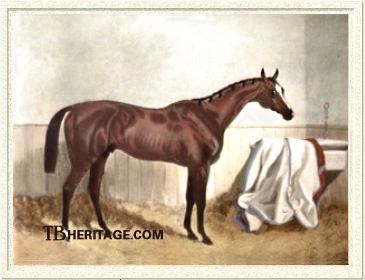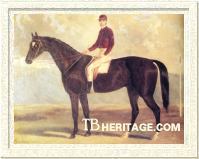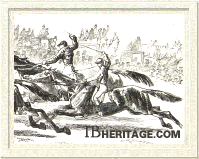|
|
Alarm (GB)

|
|
 |
|
|
Alarm was a courageous, speedy stayer that was a moderately successful stallion in England, whose greatest influence in tail-male was through his son Panic, a horse that ran well in Australia and later got many successful runners there. Alarm's daughters are seen in the distant tail-female removes of some stakes winners today.
Alarm was out of a Defence mare, Southdown, owned by Captain George Delmé of Cams Hall, Fareham, in Hampshire, not far from Stockbridge. Delmé was a son of Peter Delmé, an m.p. for Morpeth who married well and spent a deal of time pursuing hunting and other sporting interests in Hampshire. Southdown's daughter, The Arrow (1850, by Slane) was later dam of the good Newminster colt Cambuscan, sire of the outstanding nineteenth century race mare Kincsem.
Alarm had "wonderful hips, which might belong to a massive steer," and reportedly had a bit of a temper, a characteristic his sire, Venison, supposedly passed on to some of his offspring, notably the famous Cruiser, although Venison himself was a good-tempered animal. Like Venison, and his grandsire Partisan, he had an "Arabian-looking" head with a small muzzle and large eyes, good shoulders, a wiry frame and good legs and feet. He was a versatile runner, winning races from a mile to 3 miles. He died in July of 1862, age 20, at Barrow's in Newmarket, "little more than a splendid ruin" with "one eye knocked out" and foundered "for many years."
Alarm on the Turf
Delmé first ran Alarm at the local Bilbury Club meet at Stockbridge, where he won the Champagne Stakes by a length, beating a very good field of juveniles that included Chesterfield Stakes winner Lady Wildair, the Defence filly Aegis, and Nutbourne, by Elis. Charles Greville bought ALARM after this race, and Alarm ran in Greville's colors for the rest of his career.
Alarm's next start was the Epsom Derby (won by Lord George Bentinck's The Merry Monarch, to Lord George's "grim satisfaction," Greville and and his cousin and former racing confederate, Bentinck, having had a serious falling out by then). At the start of the race, Alarm kicked out at The Libel, and The Libel retaliated by jumping on Alarm and knocking off his jockey; riderless, Alarm took off, jumping the course rails and injuring himself, but he still ran in the race, which he completed, although well back in the field. After that, Alarm was not seen on the turf again until the fall, when it became clear he was by far the best of his generation.
At Newmarket Second October Alarm beat Old England (third in the Derby) in a 500 sovereign match. At Newmarket Houghton he took the Cambridgeshire Stakes beating a field of over twenty horses, including gold cup winners Yardley and Trueboy, Oatlands winner Jet, The Baron, Wolf-Dog (winner the next year of several Queen's Plates and gold cups), Ould England, and other good ones.
In 1846, age four Alarm won all but one of his races, and that when carrying the highest weight. At Newmarket Craven he beat a Bay Middleton colt in a 500 sovereign match over the Ditch Mile course, and a few days later won the Claret Stakes over the Ditch-in Course (2 miles). At Newmarket First Spring he received a compromise in a 500 sovereign match against The Traverser. He went on to Ascot where he triumphed in the Emperor of Russia's Plate (Ascot Gold Cup) over 2-1/2 miles, beating a high-class field that included Orlando, who went lame during the running. Next up was Goodwood, where over three miles he won the Orange Prize, coming from behind in an exciting race to beat Jericho by a head. In a 300 sovereign match at Newmarket Second October against The Bishop of Romford's Cob, giving weight, he took the lead and was never headed. At the same meet he also won a 500 sovereign match over the Two-Year-Old course against Oakley, who had won four of his six races that season. Then came the Cambridgeshire at Newmarket Houghton, where, carrying 9 st-4 lbs, he was "handicapped out of the race," won by the Prior of St. Margaret's (carrying 6 st-7 lbs). Also at Newmarket Houghton he easily beat Sorella in a 1000 sovereign match; Sorella had been a very high-class filly two years earlier, winning the One Thousand Guineas, Ascot's Great Produce Stakes and Doncaster's Park Hill Stakes in 1844.
The next year, 1847, Alarm was slated run a match against Paragone and The Baron, but received compromise funds in lieu of the running from both parties. His next race, also at Newmarket, was a 1000 sovereign match against the much inferior The Traverser; he lost, conceding 14 pounds to the winner, and that was the end of his career on the turf.
Alarm in the Stud
Standing at stud for Greville at Hampton Court until the early 1850s, and later at Newmarket, he was a moderately successful stallion, and was frequently in the top twenty leading sires, but seldom very high on the list, getting many winners at minor venues, and a few good ones that took big races. His offspring won at all distances, although most were stayers, some of which won most of the big distance handicap races. The ability to go a distance was remarkably consistent through several generations of his descendants. His daughters tended to throw stayers, and some of their sons and grandsons became sires of good jumpers. The only classic winner closely associated with Alarm was 1866 Oaks Stakes winner Tormentor, out of Alarm's daughter TORMENT.
His sons included GRAPESHOT (1850, from Volley byVoltaire), a good stayer that won the 1 mile-6 furlong Great Yorkshire Handicap, the two mile Northumberland Plate, and the 1853 two mile Queen's Plate at Ascot, among other races. He was later sent to Austria, where he died in 1857. WINKFIELD (1851, from a mare by St. Nicholas), won the Ascot Gold Cup (2-1/4 miles), the Queen's Plate at Egham in 1855, and in 1856 the Royal Plates at Chelmsford and Egham. TELEGRAM (1855, out of Espeth-Birdcatcher), won the one mile Belvoir Castle Stakes at Croxton at age three, and went on to take the 2-1/4 mile Great Metrpolitan Stakes handicap. PAX (1856, from Premature-Touchstone) won the Great Ebor Handicap over 1-3/4 miles, and his brother, PITAPAT (1853), took the St. James's Palace Stakes. SUSPICION (1861, from Blue Bell-Heron) won the Goodwood Stakes over 2 miles-3 furlongs. SENTINEL (1854, his dam Plush byPlenipotentiary) won the two mile Wiltshire Stakes at Salisbury. Greville's KAFFIR (1851, out of Jamaica-Liverpool) took the Great Warwick Handicap, and won several matches at Newmarket, and another Greville colt, the gelded INVASION (1850, from Alkali-Slane) also won several matches at Newmarket. PEON (1861, out of Repentance-Annandale), won the King Edward VII Stakes and the Ascot Derby, and was second in Goodwood's Gratwicke Stakes; his brother, STAMPEDO (1858) won the Lewes Handicap at age three. PEON later stood at Sutton Place, near Guildford, for a fee of 5 guineas (his stablemate, the Stockwell son, Thunderbolt, stood for 25 guineas). MIDDLETON (1853, from The Darter-Tearaway) won Queen's Plates at Ascot and Canterbury at age three.
Alarm's juvenile winners included THE AMOROUS BOY (1854, from Amata by Velocipede, winner of Lincoln's Two Year Old Stakes and Derby's Scarsdale Stakes); ORION (1858, Beaufort Cup at Monmouth, Cardiff's Two Year Old Stakes), ALEPPO (1853, out of Palmyra-Sultan; won Brighton's Biennial Stakes as a juvenile, and at age three won several races, placing second in Ascot's Gold Vase), and Greville's FRANTIC (1849, from a Mulatto mare) was winner of the Northampton Triennial Stakes and second in Goodwood's Nursery Stakes as a juvenile; at age 3 second in the Newmarket St. Leger, and at age 4 winner of three matches at Newmarket, a race at Northampton and second in the Queen's Plate at Egham). As a juvenile, CHELMSFORD (1858, from Ninette-Slane) won the Galleywood Stakes (6 furlongs) at Chelmsford, beating older horses, the Marks Hall Stakes (4 furlongs) at the same meeting, the Town Stakes (6 furlongs) at Ipswich, again besting older colts and fillies, and was third in all all-aged sweepstakes at Newmarket First October.
None of the horses listed above became useful stallions of any note, although a few got daughters that bred on. However, several Alarm sons got some good jumpers, and two Alarm sons went to Australia, where one in particular, PANIC, had an important influence on thoroughbred breeding in that country.
COMMOTION (1854, from Dinah by Clarion), won Epsom's Woodcote Stakes as a juvenile. At age three he was second to Imperiuse in the Doncaster St. Leger and to Underhand in the 1-1/2 mile Manchester Cup. His son, the famous Captain Machell's Disturbance (1867, out of Polly Peachman-Collingwood), won the 1873 Grand National Steeplechase at Aintree and was sold shortly thereafter, doing nothing after he changed hands. COMPROMISE (1855, from Bribery-The Libel) was a good runner and weight-carrier, winning Reading's two mile Berkshire Handicap at age two, and second to Pensioner in the Ascot Stakes, to The Happy Land in the Goodwood Derby and to The Cheery Chap in the Zetland Stakes at York. In the stud he got Lord Lonsdale's long-running chaser Congress (1866, out of Countess by Slane), who, when first schooling over fences had to be "dragged over the jumps with ropes tied to cart horses." Congress was winner of numerous steeplechases, including the 1877 Grand Steeple-Chase de Paris and the Grand International Steeplechase at Sandown,as well as second in the Grand National to Austerlitz the same year, and the Grand Sefton Chase twice (1873 and 1876). Sold to Count Hunyady, COMPROMISE was sent to stud in Vienna, where he got some good runners in Austria-Hungary and Germany.
Alarm's son FRIGHT (1854, from Cytherea-Camel) went to stud at George Henry Moore's Moore Hall in Ireland, where he was a useful stallion. He got Coward (1868, Rose Noble-Hobbie Noble), winner of the Curragh's 1871 Madrid Handicap and later sire of the 1886 Irish Grand National winner Castle Lucas (1881). FRIGHT also got Rock Savage (1871), winner of of the 2 mile-6 furlong Galway Handicap steeplechase, and March Away, the dam of Quick March (1885), winner of the 1890 Leopardstown Chase.
|

Panic
| | PANIC (1858, from Queen of Beauty by Melbourne) was purchased by Samuel Blackwell in 1860, after he ran second in Beverley's Driffield Stakes, and taken to Tasmania. There he was among the top runners of his day, servicing mares while still a racehorse. He ran third to Mormon in the 1861 Australian Champion sweepstakes held at Hobart before a crowd of 10,000 wild fans, was second to the great Archer in the second running of the Melbourne Cup, and, in 1865, won the first running of the Launceston Champion Cup. Sold to Henry Phillips of Warrnambool, he stood at Phillips' Bryan O'Lynn stud near Victoria, Melbourne, until his death in 1878, getting many outstanding runners of Australia's premier distance races.
|
One of PANIC'S best runners was the gelded Nimblefoot (1863), who won both the Melbourne Cup and the 18 furlong VRC Australian Cup. Another good one, Strop (1861), also gelded, won the 24 furlong Launceston Cup twice, the Hobart Cup (16 furlong) and the VRC Town Plate (20 furlongs). Panic's son Wellington (1875) was also a superior runner in Victoria, winning nine races, among them the VRC Derby, the 24 furlong VRC Champion Stakes, theAJC Randwick Plate, and the VRC Canterbury Plate; he was later a good sire, getting Queensland Cup winner Theorist, Australian Cup winner Marmont, and a number of other good runners, including Perth Cup winner The Duke.
PANIC'S son, Commotion (1878), bred by Phillips, was a terrific, long-running, weight-carrying stayer that won ten races in four seasons of distance racing, including the VRC Champion Stakes (24 furlongs) twice, the VRC Canterubry Plate (18 furlongs) twice, the VRC St. Leger Stakes, the Launceston Cup, the VRC Town Plate and the Melbourne Stakes, always in top company and frequently conceding tons of weight. He was not a successful sire, his best being Contrast (1893), a winner of the Adelaide Cup. However, Commotion's sister, Nightmare (1876, by PANIC), was a superior broodmare, dam of Melbourne Cup winner Mentor and AJC St. Leger winner La Tosca. La Tosca was dam of Victoria Derby winner F.J.A., and tail-female ancestress of the grand Multiform siblings Nightfall (1901, New Zealand Oaks, Derby, St. Leger and Wellington Cup) and Noctuiform (1902, AJC Derby, New Zealand Derby, New Zealand Cup). Nightmare, through daughter Insomnia (1889), was second dam of the terrific Trenton filly, Wakeful (Australia's "Queen of the Turf"), and through her third dam of Melbourne Cup winner Night Watch.
PANIC got many other winners, mostly stayers, and excellent broodmare daughters whose bloodlines are woven into the fabric of Australian and New Zealand thoroughbreds.
Alarm's Daughters
Alarm got some daughters that were as good or better than his sons on the turf, and successful producers that established long-lived tail-female lines.
TORMENT (1850, from a Glencoe mare) was bred by Greville, and she was not spared during her three-year-old season, when she racked up seven wins, most over a distance. She took the Visitor's Plate at Ascot, and the two mile Surrey and Middlesex Stakes at Hampton, also winning Royal Plates at Hampton (2 miles), Winchester (2 miles), Goodwood (3 miles-5 furlongs) and York (2 miles), also winning the 2-1/2 mile York Cup at the same meeting.
TORMENT was also a good producer. She bred the King Tom filly Tormentor. Tormentor won the Caroline Stakes at Lincoln, the Knowsley Handicap and Liverpool Nursery Plate at Liverpool, and the Salopian Stakes at Shrewsbury as a juvenile. At age three she took Epsom's Oaks Stakes, and went on as a distance runner to take the Queen's Plate at Hampton and at Newmarket July, and at Stamford the Burghley Handicap and Stamford Gold Cup. TORMENT'S daughter Laura (1860, by Orlando, bred by Greville), produced Doncaster Cup winner Fraulein (1870), Craven Stakes winner Laureate (1879, by Rosicrucian), and the game Petrarch (1873, by Lord Clifden), winner of the Two Thousand Guineas and the Doncaster St. Leger, among other races. Petrarch later got four classic-winning fillies, including some that went on to influential careers in the breeding shed, The Bard, a multiple leading sire in France, and Hackler, that became an outstanding sire of jumpers in Ireland.
J. M. Stanley's MISHAP (1851, from Miss Slane-Slane) was another good three-year-old Alarm daughter. She won the 1-1/4 mile Palatine Stakes for fillies and the eight furlong Coronation Stakes at Ascot, also for fillies, took the Epsom Town Purse handicap over a mile, Epsom's Autumn Handicap, beating a good field that included Little Harry, Hungerford, and Defiance, and the Brighton Stakes, beating Ascot Gold Cup winner Winkfield and nine others. That season she was second to The Caliph in the 1-1/2 mile Bath Biennial stakes, beating Spinaway and other good ones; second to Brother to Grey Tommy in the two mile Berkshire Stakes at Reading, and third in the Cheshire Stakes, Brighton's Grand Stand Purse, and the Queen's Purse at Hampton. Her daughter, the French-bred Paladine (by Orphelin) produced Derby Belge winner Pascal (1887, by Inval).
ALERTE (1859, from Aunt Phillis by Epirus) , a half-sister to Grand National Steeplechase winner Alcibiade, was imported to France in-utero. Racing as a juvenile for her owner, la Grande Écurie (Count Legrange and Baron Nivière), in England, she won the Ascot Biennial and was second in a plate for two and three-year-olds at the same meeting. At age three, in France, she won the Grand Saint-Léger. When la Grande Écurie disbanded at the end of 1862 and its stock was auctioned off, Alerte was purchased by Thomas Hurst for 21,500 francs, one of the highest prices paid for any of the very good runners owned by the partnership. The next year her big win was the 4200 meter Prix du Cadran at Longchamp, where she beat Orphelin. ALERTE was later second dam of Azur (1880, by Vestminster), twice winner of the Prix de la Fôret.
|

Little Queen Bess, third in the Cesarewitch after a three-way dead-heat
| | Some of Alarm's other good-running daughters were VINGT'UN (1851, from an Elis mare), winner of the Harchstone Cup at Shrewsbury, Bath's Member's Handicap Plate (beating 12 others), and the two mile Great Handicap at Lewes; NERVOUS (1849, out of Rosalind-Touchstone), won several races at Newmarket and at age three a 2-1/4 mile Royal Plate at Epsom; QUEEN BESS (1854, Miss Julia-Don John), won the Derby Handicap Plate at Manchester, beating a field of two, three and four year olds, and also took the Two Year Old Stakes at the same meeting; at age three she was second in the Wolverhampton Stakes and dead-heated with the American-bred Prioress and El Hakim in the Cesarewitch at Newmarket, losing the run-off heat (won by Prioress). HAGAR (1858, Barbara-Plenipotentiary) won the Rutland Stakes at age two.
|
Some other good producing daughters of Alarm included: ALARUM (1858, out of Marie Vincent-Simoom), dam of the in-bred (to Venison) Lincolnshire Handicap winner Vulcan (1864, by Thunderbolt); ALARUM (1856, from Amata-Velocipede), dam of the 1881 Scottish Grand National winner Bellman; FRIGHT (1850, out of Brown Bess-Camel), who produced Liverpool Summer Cup winner Terror (1863, by The Hadji); CONSTERNATION (1853, from Little Fairy-Hornsea, winner of a sweepstakes for juveniles at Stamford), the dam of Ackworth (1861), who won the Cambridgeshire Stakes at age three and the Doncaster Cup at age four; THE PEARL (1850, from Hester-Camel; The Pearl ran dead last in all three of her races as a juvenile), owned by Count Batthyany, produced the 1866 Grand Prix de Paris winner Ceylon; Ceylon was later the sire of the 1880 Grand Steeple-Chase de Paris winner Recruit (1873).
--Patricia Erigero
|
|
|
|

